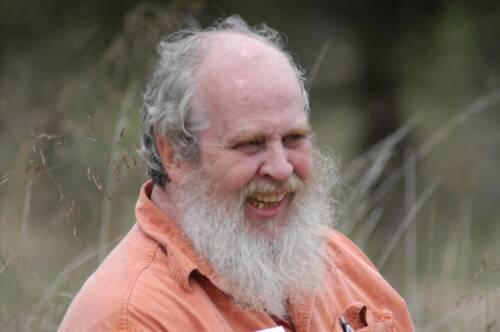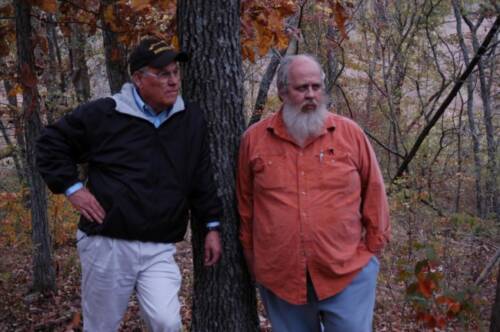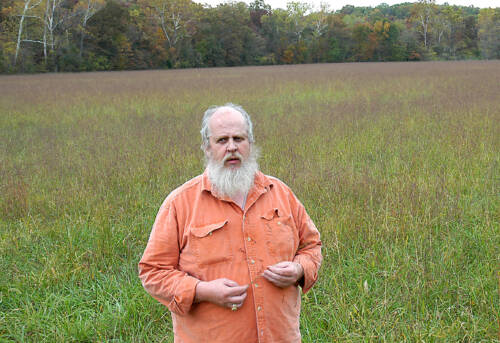Sarah Lovell officially joined the University of Missouri College of Agriculture, Food and Natural Resources (CAFNR) in August 2019, as the H.E. Garrett Endowed Chair Professor and director of the Center for Agroforestry. Two months later, Lovell, who became just the second individual to hold the endowed chair position after Shibu Jose served eight years in the role, welcomed guests to the grand opening celebration of the Land of the Osages Research Center.
Neither the H.E. Garrett Endowed Chair Professorship nor the Land of the Osages Research Center would have come to fruition if Gene Garrett would have ignored a Post-it Note with a name and phone number on it back in 2003.
Garrett was transitioning into the director role in the School of Natural Resources (SNR) at that time, replacing Al Vogt, who had retired. As Garrett was moving into his new office, only two things remained on his soon-to-be-new desk – the Post-it Note and the office telephone. The note had Doug Allen’s name and phone number on it. Garrett gave the number a call after getting settled and left a message.
A couple months later, Garrett, who was also the director of the Center for Agroforestry, received an email from Allen. Allen had purchased some land and was looking for help with how to manage it. He was interested in learning more about agroforestry as well. The conversation that followed became the first of many discussions over the course of nearly 15 years.
 Doug Allen
Doug Allen“Doug didn’t want the land to be used for conventional purposes, and it really seemed like agroforestry practices would be a good fit for him,” Garrett said. “He had a specific vision and wanted help reaching those goals. That’s exactly what we’re here for.
“It’s incredible to think that a simple conversation about agroforestry became so much more.”
Those early conversations eventually led to an important friendship with Allen, not only for Garrett, but also for Dusty Walter, director, natural resources management, CAFNR Office of Research; Darcy Wells, CAFNR senior executive director of advancement; and Jose, associate dean, CAFNR Office of Research.
Allen passed away in 2017. He created two endowments before he died and left everything he had to the University of Missouri, including the more than 500 acres that became the Land of the Osages Research Center. His gifts have allowed for and will continue to open the door for more agroforestry research – as well as unique partnerships and collaborations for CAFNR and Mizzou.
“As much as we appreciate and look forward to the opportunities he’s created for us, he is certainly missed,” Walter said. “We are going to be able to do some really interesting and unique things with the new research center, but I will really miss going down there and sharing a drink and a laugh with Doug.”
An Agroforestry Interest and Future Investment
After their first discussion, Garrett made a trip to the Lake of the Ozarks area, around Laurie, to take a look at Allen’s land. Walter tagged along as well, as he was working for the Center for Agroforestry at that time.
“Doug had a big interest in wildlife management, especially quail,” Walter said. “He grew up in a family that enjoyed hunting and fishing, so the management of those species was incredibly important to him. We definitely found some common ground to talk about.”
Garrett and Walter shared some agroforestry practices that Allen could implement. Garrett said Allen was thrilled to hear about some of those ideas, and the group continued to stay in touch.
Just a few months after their first meeting, in early 2004, Garrett received a call from Allen that seemed a little different than their normal conversations. That discussion was followed by a call from Allen’s attorney. His attorney said that Allen wanted to change his will and leave everything to MU, specifically, the Center for Agroforestry, including all of his land, which would eventually become the Land of the Osages Research Center.
 Doug Allen, right, and Gene Garrett formed a lifelong friendship after the two started discussing ways to implement agroforestry practices on Allen’s land.
Doug Allen, right, and Gene Garrett formed a lifelong friendship after the two started discussing ways to implement agroforestry practices on Allen’s land.“I was really surprised that he wanted make a gift of that nature,” Garrett said. “I honestly didn’t even really know that much about Doug. We had had a few conversations, but that was really about it. I wasn’t even sure what he had to give, other than the land. It was really out of the blue.”
Garrett reached out to Wells to help with the gift. After working through everything that Allen wanted to see happen, the first proposal was not accepted by Mizzou. An endowment would be needed to make everything work, especially since Allen had a desire to have his land turned into a research center.
“We talked things over with Doug’s attorney and let her know that at least $1 million needed to go into an endowment, just to cover maintenance and things of that nature,” Garrett said. “He ended up being completely fine with that. I was taken aback for sure. I couldn’t imagine that he had that type of money laying around.”
Garrett soon found out that Allen was the son of Holless Wilbur Allen, the creator of the compound bow. Money wasn’t going to be a hindrance.
“The entire time I knew Doug, he never flaunted how much money he had,” Garrett said. “He was incredibly humble.”
Along with the endowment for the future research center, Allen also created an endowment for the H.E. Garrett Endowed Chair Professorship. That endowed position is tied to the Center for Agroforestry.
“One of my favorite memories of Doug was the night we announced that endowed chair,” Wells said. “There were just a few of us there for dinner at Sycamore, and it was a complete surprise for Gene. Doug never wanted anything named for himself, and he really respected Gene. I know Gene was very honored.”
Seeing the Potential
Allen was part of the interview process when Jose interviewing at the University of Missouri in 2008. Jose was interviewing to be the director for the Center for Agroforestry. He would also hold the endowed professorship title if he accepted the job.
“I remember the blizzard-like conditions during that week, and I barely got into Columbia for the interview process,” Jose said. “Doug couldn’t make the trip, but we talked over the phone. I could tell right away that he was very passionate about agroforestry.
“Honestly, he was a big part of why I came to Mizzou. I was looking at an opportunity to lead a unique program, and it was comforting to know that there was someone there who was so invested and was backing that investment up. He saw how much potential there was here to grow the Center for Agroforestry.”
Jose accepted the job and continued to build on two strong programs – the Center for Agroforestry and the Horticulture and Agroforestry Research Center (HARC), located in New Franklin. He said he was always thankful that Allen welcomed him with open arms.
“I would thank Doug all of the time,” Jose said. “He never understood why I did – he wanted me to thank Gene since Gene helped build so much of what I came in to. I knew Doug had given the money to create the professorship, but that wasn’t important to him. He was so humble about it.”
Garrett and Walter had been working with Allen on his land for a couple years before Jose joined CAFNR. Along with wildlife management, forest farming and medicinal plants were interests for Allen. There had even been a few field days related to those topics hosted at Allen’s property.
“Once we had an agreement in place, it was only natural that we participated in the management of the land,” Walter said. “Everything we did was based on Doug’s vision, but we helped him with various aspects and in different ways. Doug wanted the land to be a community asset.”

The partnership in land management continued until Allen’s death. Multiple workshops and field days took place at the property throughout that time.
“Doug was certainly a man who took things seriously and he really thought things through,” Walter said. “He was a deep thinker and thought outside the box. He had his way of doing things, and it was always fun to work with him through projects. It was always interesting.”
Just before his death, Allen became fascinated with learning more about his land. He found out that the Osage Nation had deep ties to the land. He wanted the future research center to be named for a specific Osage chief.
“We spent a lot of time talking about the land, not just from a management perspective,” Garrett said. “He just enjoyed the land and learning more about it. It was incredible all he was able to find out.
“Naming is obviously a big part of creating a research center. In our minds, the center would be named after Doug. He flat out refused that request. He wanted the center to be tied to the Osage Nation.”
CAFNR reached out to the Osage Nation during the naming process after Allen’s death. After a few discussions, the decision was made to have the center represent all of Osage Nation, thus the name Land of the Osages Research Center.
“I think Doug would absolutely love it,” Garrett said. “I hate that we weren’t able to connect him with the Osage Nation. He would have enjoyed getting to know them and sharing the land with them.”
“This center is very exciting,” Wells added. “I’ve been in higher education fundraising for 25 years, and I’ve never worked on a gift this wonderfully unique. Doug did so many great things during his lifetime and built quite a legacy. I miss not having regular contact with him. It’s always fun to find old email conversations we had. He was a great guy.”
A Big Personality
It became an annual tradition for Allen to meet the Mizzou group individually for holiday dinners, generally in the Kansas City area. He loved good food and a good drink – and also loved to tell jokes.
“He always wanted to tell jokes,” Jose said. “He would also challenge others to tell him jokes. I was always curious where Doug got his jokes. He told me that he actually collected them, and would practice telling them. He loved to make people laugh.”
“You always knew when Doug called the office because the person on the receiving end would definitely be chuckling,” Wells added.
Garrett and Walter spent plenty of time with Allen on his property, smoking cigars and taste testing a variety of beverages.
“Doug had something different every time we were down there,” Walter said. “I’m a scotch and bourbon guy. Doug was more of a liquor guy – he liked a little sweeter drink. We would try a little bit of everything. That was the thing about Doug, though. If he knew you liked something, he would buy it for you and try it out for himself. It was always fun and interesting.”
Garrett said once Allen had made up his mind on an issue, there really wasn’t anything anyone could do to change his mind. It was still fun to talk through his process, Garrett added.
“When Doug passed, I lost one of my best friends,” Garrett said. “I still feel like he’s steering the ship down here, though. He’s left us in a great position to do so many great things. It’s so, so exciting.”